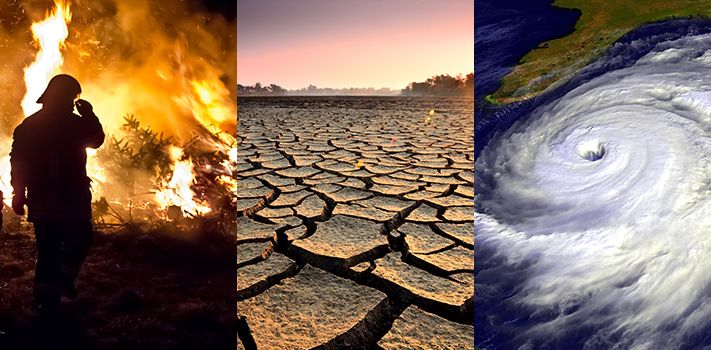DENVER — Last year, the Earth’s fever didn’t go away. It didn’t reach a record high, but government groups say it was still one of the five or six warmest years on record.
Scientists from the US government, on the other hand, say that climate change caused by burning coal, oil, and gas will make the next few years the hottest on record.
Despite a La Nina, a cooling of the equatorial Pacific that somewhat lowers world average temperatures, the United States National Oceanic and Atmospheric Administration says 2022’s global average temperature was 14.76 degrees Celsius, placing it sixth on record. Because of data concerns, NOAA still needs to include the polar regions but will do so soon.
If the Arctic, warming three to four times faster, and Antarctica are included, NOAA says it will be the fifth warmest on record. Traditionally including the Arctic in its worldwide estimates, NASA stated that 2022 is tied for the fifth warmest with 2015. Four other scientific institutions or organizations worldwide rank the year as the fifth or sixth hottest on record.
NOAA And NASA Have Records Dating Back To 1880.
NASA Administrator Bill Nelson stated that global warming is “very alarming… What we’re seeing is our warming climate warning us all. The intensity of forest fires is increasing. Hurricanes are becoming more powerful. Droughts are wreaking havoc on the environment. The sea level is rising. Extreme weather patterns endanger our well-being all around the world.”
According to Berkeley Earth, a nonprofit collection of independent scientists, it was the fifth warmest and hottest year for 28 countries, including China, the United Kingdom, Spain, France, Germany, and New Zealand.
Another group, whose satellite-based estimations are typically cooler than other science teams, claimed it was the fifth hottest year.
2022’s Climate Was Hotter Than 2021
Last year was slightly hotter than 2021, but scientists believe the real issue is that the last eight years, beginning in 2015, have been a step above the increased temperatures the world has been experiencing. According to NOAA and NASA, the last eight years have been warmer, over 1.8 degrees (1 degree Celsius), than pre-industrial times. According to NASA, last year was 1.1 degrees Celsius warmer than in the mid-nineteenth century.
“The previous eight years have certainly been warmer than the years before,” said Russ Vose, chief of NOAA’s analysis section.
In a human body, an extra 2 degrees Fahrenheit is considered a fever, but Renee McPherson, a University of Oklahoma meteorology professor who was not part of any of the study teams, believes global warming is worse than the equivalent of a planetary fever because fevers can be treated to go away quickly.
“You can’t take a pill for it. Therefore the solutions aren’t simple,” McPherson explained. “It’s more of what you’d call a chronic sickness, like cancer.”
Each Year Will Get Warmer And Warmer
“Every tenth of a degree matters and things break down, and that’s what we’re witnessing,” says Climate Central Chief Meteorologist Bernadette Woods Plucky, comparing the situation to a fever.
The World Meteorological Organization says that it is more likely that the world will warm more each year than the 1.5 degrees Celsius (2.7 degrees Fahrenheit) limit agreed upon in 2015. According to the United Nations Weather Service, the previous ten years have been 1.14 degrees Celsius warmer than pre-industrial periods. Vose says there is a 50/50 chance that the temperature will briefly reach 1.5 degrees Celsius in the 2020s climate.
Vose and NASA Goddard Institute Director Gavin Schmidt stated that there are indications of an acceleration in warming, but the data isn’t yet solid enough to be certain. However, they claim that the overall warming trend is unbreakable.
“You’ve seen this steady increase in temperature since the mid-1970s, and that’s completely resistant to all the different approaches,” Schmidt said.
La Nina Will Happen More Often
La Nina, a natural phenomenon that affects weather worldwide, is in its third year. Schmidt concluded that the La Nina lowered overall temperatures by around a tenth of a degree (.06 degrees Celsius) last year, even though it was the hottest La Nina year on record.
“The La Nina years of now are not yesterday,” said Kathie Dello, a state climatologist in North Carolina. “In the past, we could count on La Nina to lower the world thermostat. Heat-trapping gases keep the temperature high, ensuring another top-10 warmest year on record.”
With La Nina likely receding and a possible El Nino on the horizon, Schmidt predicts that this year’s climate will be warmer than 2022. And keep an eye out for an El Nino next year.
“That would imply that 2024 would be the warmest year on record by a significant margin,” Schmidt said
Scientists estimate that 90% of the heat trapped by greenhouse gases ends up in the upper 6,561 feet (2000 meters) of the ocean, and numbers released Wednesday suggest that 2022 will be another record year for ocean heat.
“There’s a fairly good connection between the patterns of ocean warming, stratification, and then the weather that we experience in our daily life on land,” a research co-author of the University of St. Thomas said.
Global warming first made news in the United States in 1988, when Schmidt’s predecessor, climate scientist James Hansen, testified about worsening warming. That year would be the warmest on record.
1988 Is Now The 28th Warmest Year On Record.
According to NOAA, the last time the Earth was cooler than the 20th-century average was in 1976.
However, scientists believe that average temperatures do not significantly impact humans and climate. What bothers and upsets people is how global warming makes extreme weather events like heat waves, floods, droughts, and storms harsher, more frequent, or both.
“These trends should concern everyone,” said Natalie Mahowald, a climate scientist at Cornell University who was not part of the study teams.
According to WMO Secretary-General Petteri Taalas, these extremes will “undermine health, food, energy, and water security, as well as infrastructure” in 2022. Large parts of Pakistan were inundated, resulting in significant economic losses and human deaths. Heat waves of unprecedented proportions have been recorded in China, Europe, and North and South America. Long-term drought in the Horn of Africa threatens a humanitarian disaster.
SOURCE – (AP)













